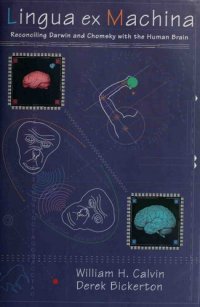
Ebook: Lingua ex Machina: Reconciling Darwin and Chomsky with the Human Brain
- Tags: 1. Neurolinguistics. 2. Brain–Evolution. 3. Chomsky Noam. 4. Darwin Charles 1809-1882. I. Bickerton Derek. II. Title.
- Year: 2001
- Publisher: MIT Press
- Edition: 1
- Language: English
- pdf
A neuroscientist and a linguist show how evolution could have given rise to structured language.
A machine for language? Certainly, say the neurophysiologists, busy studying the language specializations of the human brain and trying to identify their evolutionary antecedents. Linguists such as Noam Chomsky talk about machinelike "modules" in the brain for syntax, arguing that language is more an instinct (a complex behavior triggered by simple environmental stimuli) than an acquired skill like riding a bicycle.
But structured language presents the same evolutionary problems as feathered forelimbs for flight: you need a lot of specializations to fly even a little bit. How do you get them, if evolution has no foresight and the intermediate stages do not have intermediate payoffs? Some say that the Darwinian scheme for gradual species self-improvement cannot explain our most valued human capability, the one that sets us so far above the apes, language itself.
William Calvin and Derek Bickerton suggest that other evolutionary developments, not directly related to language, allowed language to evolve in a way that eventually promoted a Chomskian syntax. They compare these intermediate behaviors to the curb-cuts originally intended for wheelchair users. Their usefulness was soon discovered by users of strollers, shopping carts, rollerblades, and so on. The authors argue that reciprocal altruism and ballistic movement planning were "curb-cuts" that indirectly promoted the formation of structured language. Written in the form of a dialogue set in Bellagio, Italy, Lingua ex Machina presents an engaging challenge to those who view the human capacity for language as a winner-take-all war between Chomsky and Darwin.
A machine for language? Certainly, say the neurophysiologists, busy studying the language specializations of the human brain and trying to identify their evolutionary antecedents. Linguists such as Noam Chomsky talk about machinelike "modules" in the brain for syntax, arguing that language is more an instinct (a complex behavior triggered by simple environmental stimuli) than an acquired skill like riding a bicycle.
But structured language presents the same evolutionary problems as feathered forelimbs for flight: you need a lot of specializations to fly even a little bit. How do you get them, if evolution has no foresight and the intermediate stages do not have intermediate payoffs? Some say that the Darwinian scheme for gradual species self-improvement cannot explain our most valued human capability, the one that sets us so far above the apes, language itself.
William Calvin and Derek Bickerton suggest that other evolutionary developments, not directly related to language, allowed language to evolve in a way that eventually promoted a Chomskian syntax. They compare these intermediate behaviors to the curb-cuts originally intended for wheelchair users. Their usefulness was soon discovered by users of strollers, shopping carts, rollerblades, and so on. The authors argue that reciprocal altruism and ballistic movement planning were "curb-cuts" that indirectly promoted the formation of structured language. Written in the form of a dialogue set in Bellagio, Italy, Lingua ex Machina presents an engaging challenge to those who view the human capacity for language as a winner-take-all war between Chomsky and Darwin.
Download the book Lingua ex Machina: Reconciling Darwin and Chomsky with the Human Brain for free or read online
Continue reading on any device:

Last viewed books
Related books
{related-news}
Comments (0)